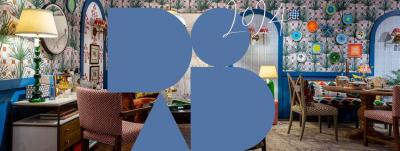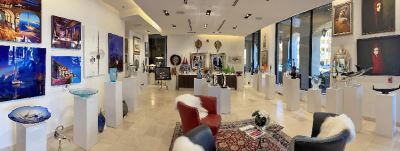Timothy Schreiber A Fluid Future for Design
 |
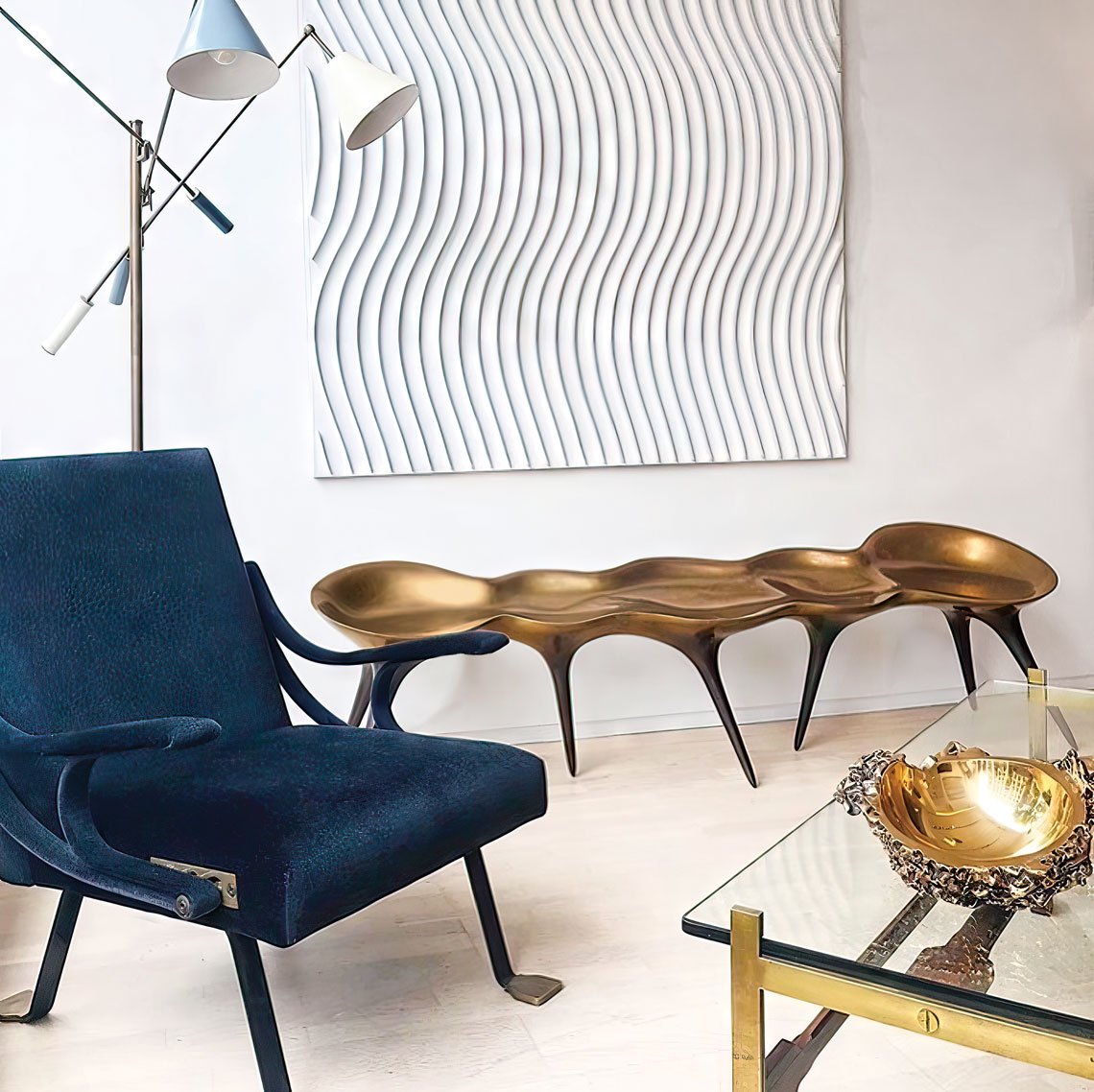 |
The organic meets the futuristic in Timothy Schreiber’s cast bronze Molecule Bench, which combines a mirror-polished seat with gradient-patinaed legs. This made-to-order design can be customized with different finishes and number of seats. Available from 88 Gallery through Incollect.com. |
by Benjamin Genocchio
 |
Timothy Schreiber is an artist, designer, architect, and a fascinating and enthusiastic raconteur. Speaking with him from his London studio, he is eager to recount the many revelatory experiences he had while traveling the world, coming upon a material or a local cultural craft process that influenced how he creates his organic, seemingly liquid sculptural furniture.
Fluidity is the story of his life and his art.
Raised in southern Germany, Schreiber aspired, at the age of 18, to be a master carpenter and so apprenticed in the shop of a local cabinetmaker. After completing his apprenticeship, he followed the centuries-old tradition of German master craftsmen, that of going on a journey (“Wanderschaft”) to see the world and expand his knowledge and skills. “During this time I worked and gained more practical experience in various workshops in Europe and America, including, memorably, at Fetzer’s Architectural Woodworking in Salt Lake City, Utah where I developed an interest in contemporary design,” he says. He drifted back to Weimar, Germany, birthplace of the Bauhaus, to study architecture and decided to become an architect. His first job after graduation was in Sydney, Australia as an architect, and a few years later, he wound up in London working for pioneering architect Norman Foster.
Schreiber was always designing furniture. “I had this idea I would design something and give it to an Italian brand to manufacture and get royalties but it never worked out that way.” His first designs were too complex, the big brand gurus said, and too expensive to manufacture commercially and make a profit. So he changed course and designed minimalist, zen-inspired items and took them back to Milan. Too simple, “Those are for Ikea,” said the gurus, try again.
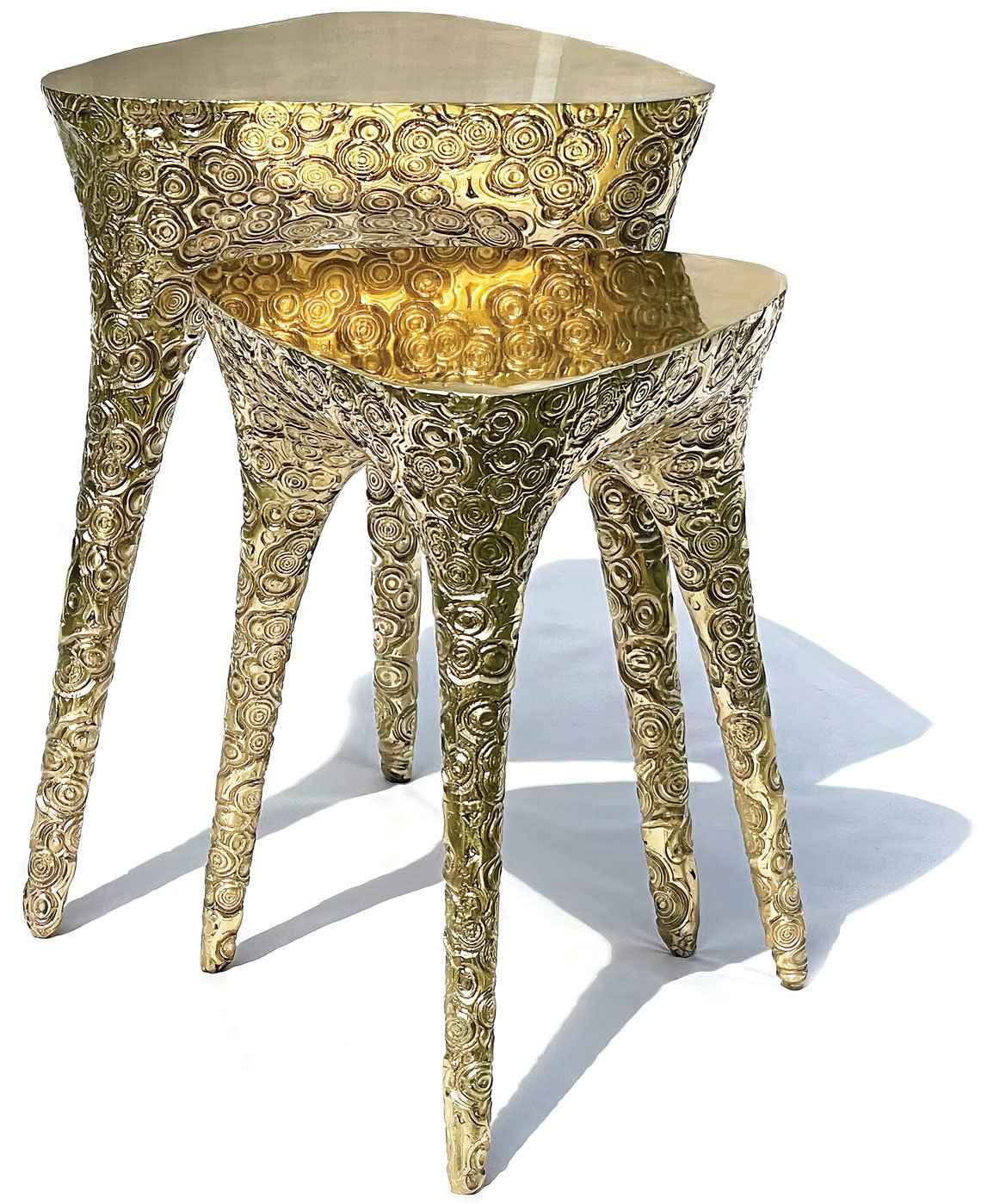 | |
The handmade Diakosmisi Occasional Tables feature a tripod structure with Gustav Klimt-inspired textural design and a smooth polished top. Available from Van den Akker through Incollect.com. |
As a young architect, Schreiber worked for Foster + Partners for 4 years before taking a job in the offices of Zaha Hadid, the Iraqi-born architect and Pritzker prize winner who used abstraction in art, computer modeling, and advances in building materials to imagine fresh building designs, prompted in part by her lack of training in traditional architectural drawing. The result was buildings of striking originality and fluidity along with furniture that was as beautiful and inventive as her buildings.
Working as an architect in Zaha Hadid’s London offices enabled Schreiber to witness how the star architect and designer crafted limited edition furniture that was sold as collectible design through art galleries worldwide. He started creating his own designs influenced by her organic shapes, and then began to work with the art dealer Lewis Wexler in the United States who was, he says, “the first person who believed in my talent and design.” Soon after he began a collaboration with London-based 88 Gallery, which proved immediately fruitful. “Everything I could make was being sold and for the first time I could make a living as a designer.”
“Timothy Schreiber’s work caught our eye immediately due to its strong, architectural lines which combine with fluid, organic shapes to form truly unique pieces,” say Erik Müllendorff and Kate Campbell, the owners of 88 Gallery in London. “His knowledge of materials and ability to combine form and function are exceptional. One of our favorite pieces at the gallery is his limited edition Molecule Bench which is a true piece of functional art and an eminently collectible work of contemporary design.”
 |
The E-Volved Centre Table by Timothy Schreiber is evocative of natural forms and the process of growth, as the three polished brass table legs grow and branch together to form the “crown” of the structure, which supports an etched glass top. Available from 88 Gallery through Incollect.com. |
His work stands out in contemporary design, the dealers say, due to the organic and sinuous quality of his shapes — something they believe is so often missing from today’s computer-generated designs. “His work has its roots in natural forms, and his lines are fluid. Timothy's experience working with Zaha Hadid may well have enhanced his ability to reconcile form and function. The Molecule Bench is both comfortable and eminently sculptural.”
Hadid may have been an initial and formative design influence on Schreiber but this is where the similarity ends. Whereas Hadid often designed furniture to complement her architecture using advanced technological processes and industrial materials with sick finishes that could be curved or shaped to the desired forms, Schreiber took the opposite approach to his designs. He works primarily with traditional materials like cast bronze or marble to create pieces that are tactile, luxurious and functional.
 | 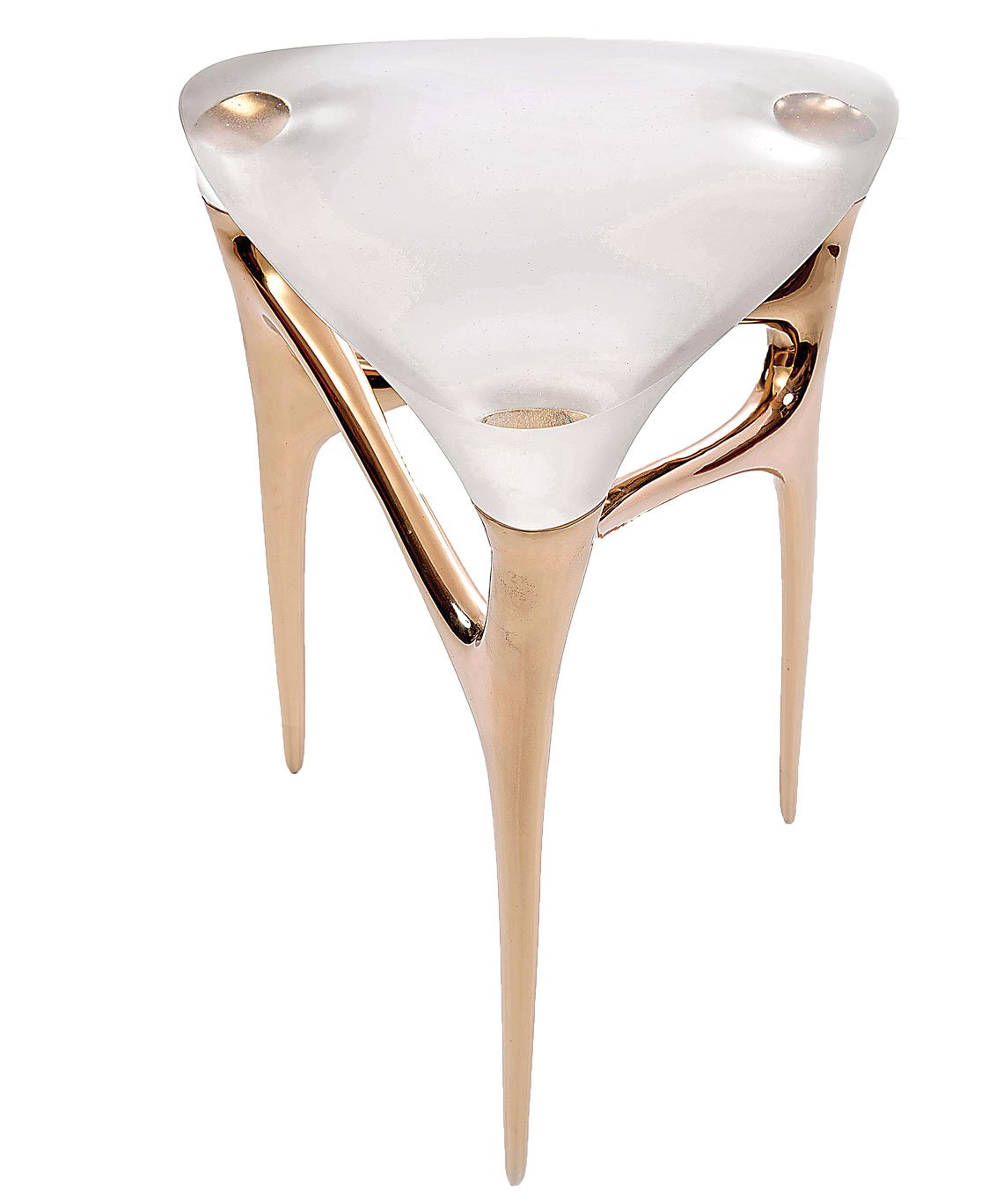 | |
The Methodology Table by Timothy Schreiber. Top left: Fully polished in cast bronze, in an edition of 12 plus 2 artist’s proofs. Signed, numbered and dated. Also available with graded patina legs and a fully polished top, made exclusively for 88 Gallery. Top right and bottom: With a cast glass top, the three-legged base in mirror-polished bronze gleams softly through the surface. Available from 88 Gallery through Incollect.com | ||
 |
“The first piece I made in 2005 was a hammer-formed aluminum table influenced by the fact that at that time Hadid was into polished silver surfaces, carbon fiber and car paints,” Schreiber says. He also created his first chaise in fiberglass but realized the design market wanted more traditional materials. “So after the early days of using more contemporary materials, I came back to a traditional approach, with contemporary forward-looking designs and visual language, but using traditional craft techniques and raw materials.”
Understanding and respect for the inherent qualities of his materials and an ability to shape them in unique and inventive ways is one of the qualities that Müllendorff and Campbell say they admire about his work. “His work is deceptively simple. If you look carefully, you can appreciate his selection of exceptional pieces of marble sourced at quarries around Carrara and Pietrasanta and his inventive use of traditional craft techniques to bring out all of the attributes particular to bronze and stone.”
 |
Drawing upon his training as an architect, the design for Schreiber’s Morphogenesis Lounge Chair began with extensive research into natural structural systems and microstructures. Handmade to order in polished or patinated bronze, upholstered in fur, and available from Galerie des Lyons through Incollect.com. |
 |  |
Müllendorff and Campbell point to the base of his Metamorphosis Console as an example, which is constructed of tubes that vary in width, evoking the branches of a tree and their movement in the wind. “The cloud-like marble surface, so brilliantly hand-finished by specialist artisans in Italy, could be read as a nod to Magritte. This piece is also a brilliant example of Timothy’s ability to combine materials: the transition from the bronze stem to the hand-finished marble surface is flawless. Despite the weight of the marble, the piece appears to float in space.”
 | |
The limited edition Metamorphosis Console by Timothy Schreiber. A Carrara marble top and base in polished bronze offer an enchanting contrast in texture and surface. An angular, branching, polished bronze structure merges fluidly into a soft, undulating cloud-like sculpted marble form. Available from 88 Gallery through Incollect.com. |
Schreiber has recently experimented with cast glass, further extending his repertoire of sculptural furniture design. “The first experiments I made with glass were relatively successful with good feedback, but the sales were better in the US — I think people in Europe were a bit afraid the pieces were going to break,” he says, laughing. “Glass is an interesting material and I am planning to make new and larger pieces. It is slightly more expensive than bronze to create furniture pieces in cast glass but I think it enables me to do things that are harder to achieve in metal or stone.”
Schreiber doesn't have a set working process, he says, though he likes to work hands-on with various iterations in different formats before finalizing a design. He will often begin sketching on paper and making small-scale models to test out forms, materials and ideas. “I have a cabinetmaking background so I love making models,” he says. “I also do computer models and then build it up in 3D so I can look at it and see options. Then I make larger physical models again, decide on the final version, and take it to the foundry, glassmaker, or the marble workshop.”
The fluidity of his working process is undoubtedly part of what makes his work so distinctive and why it is so compelling to collectors. Van den Akker in New York, Schreiber’s current American dealer, met the artist through a client, a collector of his work, and immediately knew he was a special talent. “Timothy’s work exemplifies everything we look for in a collection, a focus on craftsmanship with a career demonstrating a carefully evolving design aesthetic,” said Sean Robins and Rob Copley from Studio Van den Akker. “We felt strongly that Timothy’s work is an important part of the design conversation today, as it merges a one-of-a-kind sculptural quality with practicality that is difficult to find in the mass-produced world we live in today.”
So what’s next for the restlessly inventive creator?
 |
Ice Occasional Tables are available singly or as a pair. Cast bronze tripod bodies flow into a biomorphic-shaped top embellished with brass marquetry detail. Available from Van den Akker through Incollect.com. |
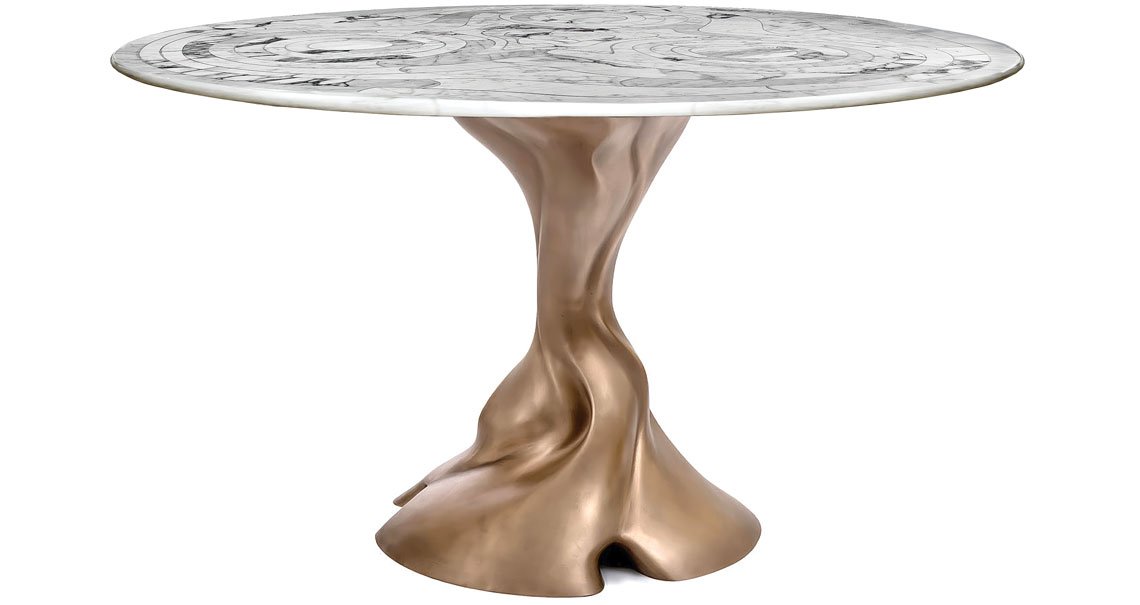 |
A round marble top with a swirling mosaic design and an organically shaped base in cast bronze are combined in the Kataigis Table. Fully customizable; the top is also available in crystal. Handmade by the artist in the UK and available from Van den Akker through Incollect.com. |
Schreiber has always liked traveling across the globe, where he finds endless inspiration in traditional local crafts and experiments with how to apply them to his contemporary designs. Following a recent visit to Kyoto, Japan, he experimented with traditional handmade fabrics used for making kimono obis — the fabric itself is called Nishijin-ori — to cover stools and tables. A pair of stools made of a hammer-formed brass base and Nishijin-ori upholstery with gold threads woven in are currently on display at Van den Akker in Los Angeles, where Tim has a show coming up.
“I went to the traditional weaving district in Kyoto called Nishijin. They have these old looms in traditional wooden townhouses and you see the centuries-old crafts and the original technology. They really can make any shape or design in this old-fashioned way but what is striking is that this process delivers incredible quality,” Schreiber says. “I pair it with a contemporary design, mixing old and new, and the stools showing at Van den Akker are the outcome of this approach. I think I will explore it more.”
 |
Top left: Nishijin Table and Stool with gold thread embellished Japanese obi fabric upholstery, from Van den Akker through Incollect.com. Top right: The wall-mounted Methodology Console features a satin finish top with a polished base shown here in brass, also available in stainless steel. Available from Van den Akker through Incollect.com. Bottom: Micron Stools in gold patina bronze with double matte and glossy finish, or mirror finish silver patina bronze. Available from Galerie des Lyons through Incollect.com. |
Schreiber was fascinated with Japan and in addition to working with fabric makers he has also started work with a traditional pottery place making Kawara roof tiles. “I love the color and that silver sheen and I want to apply it to furniture.” He has also started with metal and marble marquetry, producing dining and side tables that are also with Van den Akker. In addition, he recently started making a series of bronze designs in collaboration with Rincker, a German bell foundry in business since 1590 that also specializes in art casting.
Schreiber isn’t concerned about his progress with new techniques and materials. “I am rejuvenated by this,” he says, “my inspiration is in learning from traditional craftsmen and in updating past materials, ideas, and tools. When I worked for Zaha Hadid, people were always trying to reinvent the wheel. In the creation of studio furniture, there is a lot you can do with the wheels we have had for centuries. It's just that many makers have forgotten about them.”
 |
Discover More from Timothy Schreiber on Incollect















